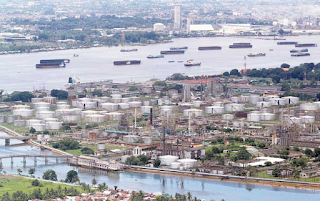Inpex Corporation has included the concept documents for the pre-front end engineering design (Pre-FEED) development of the Abadi Field, the Masela Block to the government. Referring to the 2018-2027 Indonesia Gas Balance, the Masela Block is targeted to start operating in 2027.
"The Masela project is now pre-FEED," said Deputy Minister of Energy and Mineral Resources (ESDM) Arcandra Tahar in Jakarta. In this Pre-FEED he said there would be a new investment value from the Masela Block Project. Unfortunately, Arcandra is reluctant to specify how much the total project investment refers to Pre-FEED.
Originally, this Pre-FEED will be evaluated by the Special Task Force for Upstream Oil and Gas Business Activities (SKK Migas).
"After that it will be handed over to us," he added.
Once approved, then Inpex can work on a new plan of development (POD) for the Masela Block Project. Previously, in its official statement, Inpex explained that Pre-FEED was an important step to begin the development of the Eternal Field Project.
the Masela Block Project
Furthermore, Inpex will compile a POD revision referring to the Pre-FEED results and discussions with the Indonesian side so that the project becomes economically efficient and competitive.
"After the revision of the POD is approved by the government, various evaluations including detailed design (front end engineering design / FEED) will be done so that it is achieved "final investment decision (FID)," said the official statement.
As is known, initially there were two options for the liquefied natural gas / LNG plant capacity in the Masela Block, depending on the domestic gas needs. The two options are refineries with a capacity of 9.5 million tons per year (million tons per annum / MTPA) plus 150 million cubic feet per day (million standard cubic feet per day / mmscfd) and 7.5 MTPA plus 474 mmscfd.
Pre-FEED is done to determine the most appropriate option. Pre-FEED is done with one production capacity option and one island. This was in accordance with the decision after the ESDM Minister's visit to Japan on May 16, 2017. As for the warrant, it was stated that the LNG plant capacity was set at 9.5 million ton per year and pipeline gas production of 150 mmscfd. The pre-FEED covers offshore to land, offshore facilities and LNG refineries, as well as refinery location.
To guarantee the continuation of the project, the government will provide an extension of a production sharing contract (PSC) for Inpex Corporation in the Masela Block for 27 years. So the Masela Block contract will expire in 2055, instead of in 2028 like the initial contract. The decision was one of the results of a discussion between the Minister of Energy and Mineral Resources (ESDM) Ignasius Jonan and CEO of Inpex Corporation Toshiaki Kitamura in October last year.
IN INDONESIAN
Inpex Rampungkan Pre-FEED Blok Masela
Inpex Corporation telah memasukkan dokumen konsep kelayakan keteknikan dan desain (pre front end engineering design/ Pre-FEED) pengembangan Lapangan Abadi, Blok Masela ke pemerintah. Mengacu Neraca Gas Bumi Indonesia 2018-2027, Blok Masela ditargetkan mulai beroperasi pada 2027.
“Proyek Masela sekarang sudah selesai Pre-FEED,” kata Wakil Menteri Energi dan Sumber Daya Mineral (ESDM) Arcandra Tahar di Jakarta. Dalam Pre-FEED ini dikatakannya akan ada nilai investasi baru dari Proyek Blok Masela. Sayangnya, Arcandra enggan merinci berapa total investasi proyek mengacu Pre-FEED.
Sedianya, Pre-FEED ini akan dievaluasi oleh Satuan Kerja Khusus Pelaksana Kegiatan Usaha Hulu Minyak dan Gas Bumi (SKK Migas).
“Setelah itu akan diserahkan kepada kami,” tambahnya.
Setelah disetujui, selanjutnya Inpex dapat mengerjakan rencana pengembangan (plan of development/ POD) yang baru untuk Proyek Blok Masela.
Sebelumnya, dalam keterangan resminya, Inpex menjelaskan bahwa Pre-FEED merupakan langkah penting untuk memulai pengembangan Proyek Lapangan Abadi.
Selanjutnya, Inpex akan menyusun revisi POD mengacu pada hasil Pre-FEED dan diskusi dengan pihak Indonesia sehingga proyek menjadi efisien dan kompetitif keekonomiannya.
“Setelah revisi POD disetujui pemerintah, berbagai evaluasi termasuk desain rinci (front end engineering design / FEED) akan dikerjakan sehingga tercapai
keputusan investasi akhir (final investment decision/FID),” demikian ditulis dalam keterangan resmi tersebut.
Seperti diketahui, awalnya terdapat dua opsi kapasitas kilang gas alam cair/LNG Blok Masela, tergantung pada kebutuhan gas di dalam negeri. Dua opsi itu yaitu kilang berkapasitas 9,5 juta ton per tahun (million ton per annum/ MTPA) plus 150 juta kaki kubik per hari (million standard cubic feet per day/mmscfd) serta 7,5 MTPA plus 474 mmscfd.
Pre-FEED dilakukan untuk menetapkan opsi yang paling tepat. Pre-FEED dilakukan dengan satu opsi kapasitas produksi dan satu pulau. Hal ini sesuai keputusan usai kunjungan Menteri ESDM ke Jepang pada 16 Mei 2017. Adapun, pada surat perintah disebutkan bahwa kapasitas kilang LNG ditetapkan 9,5 juta
ton per tahun dan produksi gas pipa sebesar 150 mmscfd. Pre-FEED tersebut meliputi pipa offshore hingga darat, fasilitas offshore dan kilang LNG, serta lokasi kilang.
Untuk menjamin kelanjutan proyek, pemerintah akan memberikan perpanjangan kontrak kerja sama (production sharing contract/ PSC) bagi Inpex Corporation di Blok Masela selama 27 tahun. Sehingga kontrak Blok Masela akan berakhir pada 2055, alih-alih pada pada 2028 seperti kontrak awal. Keputusan tersebut merupakan salah satu hasil pembahasan antara Menteri Energi dan Sumber Daya Mineral (ESDM) Ignasius Jonan dan CEO Inpex Corporation Toshiaki Kitamura pada Oktober tahun lalu.
Investor Daily, Page-9, Thursday, Oct 11, 2018

























